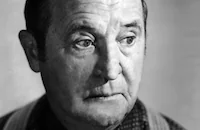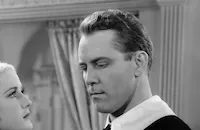Nancy Drew: Detective

Brief Synopsis
Cast & Crew
William Clemens
Bonita Granville
John Litel
James Stephenson
Frankie Thomas
Frank Orth
Film Details
Technical Specs

Synopsis
Wealthy, elderly Mary Eldredge plans to donate a large sum of money to her alma mater, the Brinwood School for Girls, at which teenager Nancy Drew is a student. She arranges to deliver the check to lawyer Carson Drew, Nancy's father, at his office the following day, but she does not appear. Hollister, Miss Eldredge's business manager, explains that she left town suddenly. Nancy, who does not believe that Miss Eldredge would act that way, determines to discover what happened. Driving home, she sees Dr. Spires kidnapped by a suspicious car. That evening, Dr. Spires calls Carson and Nancy to tell them that he was kidnapped and taken to the country to treat an injured elderly woman. Nancy is convinced that this is Miss Eldredge and that she is being held against her will. The doctor mentions that he heard his captors use a password, "bluebells." Nancy finds an injured racing pigeon bearing a message that mentions bluebells and is positive that it came from Miss Eldredge's captors. She and her friend, Ted Nickerson, release the pigeon and follow it to a house in the country where they find Hollister, but not Miss Eldredge. Nancy and Ted then realize they should look in the direction the pigeon came from rather than the direction it went toward, deciding that the pigeon must have traveled from Sylvan Lake. When Carson receives a telegram from St. Louis signed by Miss Eldredge, he leaves at once, agreeing that Nancy could go to the Lake with Ted's family. Nancy and Ted hire an airplane to look for a house that matches Dr. Spires description, then, back on the ground, they drive to Larkspur Lane, the location they found from the air, and Nancy notes that Larkspur is another name for bluebells. They return that evening and gain entry to the house by using disguises. Nancy finds Miss Eldredge, who explains that the men, led by Hollister, are trying to drive her insane and steal her money. During their escape, Ted and Nancy are kidnapped, but Ted uses an old shortwave radio to send a signal for help. Carson gets the message and together with the police, rounds up the gang.

Director
William Clemens
Cast

Bonita Granville

John Litel

James Stephenson

Frankie Thomas

Frank Orth
Helena Phillips Evans
Renie Riano
Charles Trowbridge

Dick Purcell

Ed Keane

Mae Busch
Brandon Tynan
Vera Lewis
Tommy Bupp
Lottie Williams
Buddy Bange
Crew

Videos
Trailer
Hosted Intro
Film Details
Technical Specs

Articles
Nancy Drew: Detective
In Nancy Drew: Detective, a wealthy elderly eccentric disappears after pledging $250,000 dollars to Nancy's school. Nancy is convinced the woman has been kidnapped, and with the help of her boyfriend Ted Nickerson, Nancy solves the mystery and tracks down the old lady and the kidnappers. Look for silent movie veteran and Laurel and Hardy regular Mae Busch in a small role as a nurse.
Born into a show business family, "Bunny" Granville began acting onstage at the age of three. She made her film debut at age nine in Westward Passage (1932) playing the daughter of Ann Harding and Laurence Olivier, a role she won because of her resemblance to the serenely beautiful blonde Harding. Granville was soon one of the busiest juvenile performers in Hollywood, usually in prestige productions. She was nominated for a Best Supporting Actress Academy Award for her portrayal of the spoiled, nasty little liar who ruins the careers of her teachers in These Three (1936), the first film version of Lillian Hellman's play, The Children's Hour. Those spoiled-brat roles became something of a specialty for Granville during the 1930s. By the mid-1940s, her career had slowed down, and she was cast as the leading lady in a string of routine films. She retired from the screen after her 1947 marriage to business tycoon and sometime producer Jack Wrather, although she made occasional screen appearances, and appeared frequently in television dramas of the 1950s. Granville also became an associate producer, and later executive producer, of Wrather's most successful television series, Lassie. The Wrathers were part of Ronald Reagan's inner circle, and in the 1980s, Granville served on the boards of the American Film Institute and the Kennedy Center. After her husband's death, she took over as chairman of the board of his vast business empire. Bonita Granville died of cancer in 1988.
Producer Bryan Foy was also a child of show business. His father, Eddie Foy, was a famous vaudevillian, and "Brynie" and his siblings joined the act as "The Seven Little Foys." Brynie even wrote a famous song for the vaudeville duo Gallagher and Shean, "Mr. Gallagher, Mr. Shean." Foy left the stage and began directing films at Fox in 1918. In the mid-1920s, he joined Warner Bros., directing the studio's first all-talking film, Lights of New York (1928). Eventually, he moved into producing. Among his credits is the landmark 3-D film, House of Wax (1953). Director William Clemens was one of Foy's B-unit stalwarts, directing not only all the Nancy Drew films, but also several films in the Falcon and Perry Mason series, as well an occasional Torchy Blane and Philo Vance.
Variety found Nancy Drew: Detective mildly appealing, saying, "Direction is acceptable, since it keeps the action spinning and doesn't let the subtleties impede the story. Miss Granville is forthright and refreshing as the bright-eyed heroine." The film did well enough that it was soon followed in 1939 by Nancy Drew... Reporter, Nancy Drew and the Hidden Staircase, and Nancy Drew... Trouble Shooter. After that, there were no more Nancy Drew films for nearly 40 years, though the books remained popular. In 1977, Nancy found new life on television with the Hardy Boys/Nancy Drew series, featuring Pamela Sue Martin in the title role; in the late 1990s, the first of a series of Nancy Drew video games was released.
Nancy Drew continued her onscreen adventures into the 21st century. A 2007 film, set in Hollywood, starred Emma Roberts (niece of Julia, daughter of Eric) in the title role. In 2019, Sophia Lillis played the teenage sleuth in Nancy Drew and the Hidden Staircase.
Director: William Clemens
Producer: Bryan Foy
Screenplay: Kenneth Gamet, based on the story, "The Password to Larkspur Lane by Carolyn Keen (Mildred Wirt Benson)
Cinematography: L. William O'Connell
Editor: Frank Magee
Costume Design: Milo Anderson
Cast: Bonita Granville (Nancy Drew), John Litel (Carson Drew), James Stephenson (Challon), Frankie Thomas (Ted Nickerson), Frank Orth (Inspector Milligan), Renie Riano (Effie Schneider).
BW-66m. Closed captioning.
by Margarita Landazuri

Nancy Drew: Detective
Quotes
Trivia
Notes
The film's working title was Passport to Larkspur Lane. The character "Nancy Drew" was featured in dozens of novels aimed at youthful readers, beginning in the 1930s. The novels were revised and updated, beginning in the 1980s. This was the first of four films in the "Nancy Drew" series, that ended with Nancy Drew and the Hidden Staircase in 1939. All of the films were directed by Williams Clemens and starred Bonita Granville as "Nancy Drew," John Litel as "Carson Drew" and Frank Thomas, Jr. (later called Frankie Thomas) as Ted Nickerson. For additional titles in the series, consult the Series Index. The characters were also featured in an ABC television series from 1977-1978, entitled The Nancy Drew Mysteries, starring Pamela Sue Martin and William Schallert. The television series alternated for several months with another mystery series based on youth-oriented novels, The Hardy Boys Mysteries, then the two series combined into one weekly series, Hardy Boys/Nancy Drew Mysteries that featured characters from both series.
















